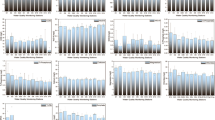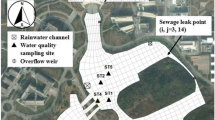Abstract
The Interconnected River System Network (IRSN) plays a crucial role in water resource allocation, water ecological restoration and water quality improvement. It has become a key part of the urban lake management. An evaluation methodology system for IRSN project can provide important guidance for the selection of different water diversion schemes. However, few if any comprehensive evaluation systems have been developed to evaluate the hydrodynamics and water quality of connected lakes. This study developed a comprehensive evaluation system based on multi-indexes including aspects of water hydrodynamics, water quality and socioeconomics. A two-dimensional (2-D) mathematical hydrodynamics and water quality model was built, using NH3-N, TN and TP as water quality index. The IRSN project in Tangxun Lake group was used as a testbed here, and five water diversion schemes were simulated and evaluated. Results showed that the IRSN project can improve the water fluidity and the water quality obviously after a short time of water diversion, while the improvement rates decreased gradually as the water diversion went on. Among these five schemes, Scheme V showed the most noticeable improvement in hydrodynamics and water quality, and brought the most economic benefits. This comprehensive evaluation method can provide useful reference for the implementation of other similar IRSN projects.
Similar content being viewed by others
References
Bi Sheng, 2014. Study on numerical simulations of hydrodynamics and pollutant transport in river and shallow lakes [D]. Wuhan: Huazhong University of Science and Technology. (in Chinese)
Chen Xiaojiang, 2010. Eutrophication status and monitoring of urban lakes in China. Science & Technology Information, (5): 416–465. (in Chinese)
Chen Zhentao, Hua Lei, Jin Qiannan, 2015. Assessing the efficacy of water diversion to improve water quality in city river network. Journal of Yangtze River Scientific Research Institute, 32(7): 45–51. (in Chinese)
Chu Junying, Qin Dayong, Wang Hao et al., 2009. Simulation of lake water environment trends in Tangxun Lake of Wuhan under rainfall uncertainty. China Environment Science, 29(9): 955–961. (in Chinese)
Cui Guangbai, Chen Xing, Xiang Long et al., 2017. Evaluation of water environment improvement by interconnected river network in plain area. Journal of Hydraulic Engineering, 48(12): 1429–1437.
Cui Guotao, Zuo Qiting, Dou Ming, 2011. Development evolution and influences of the interconnected river system network at home and abroad. South-to-North Water Diversion and Water Science & Technology, 9(4): 73–76. (in Chinese)
Cui Guotao, Zuo Qiting, Li Zongli et al., 2012. Analysis of function and adaptability for interconnected river system network. Water Resources and Power, 30(2): 1–5. (in Chinese)
Jiang Mengwei, 2014. China’s sewage charge is only 1/30 of environmental management investment. Beijing Business Today, 04-08(002). (in Chinese)
Kang Ling, Guo Xiaoming, Wang Xueli, 2012. Study on water diversion schemes of large urban lake group. Journal of Hydroelectric Engineering, 31(3): 65–69. (in Chinese)
Li Yiping, Acharya Kumud, Yu Zhongbo, 2011. Modeling impacts of Yangtze River water transfer on water ages in Lake Taihu, China. Ecological Engineering, 37(2): 325–334.
Li Yiping, Tang Chunyan, Wang Chao et al., 2013. Assessing and modeling impacts of different inter-basin water transfer routes on Lake Taihu and the Yangtze River, China. Ecological Engineering, 60(11): 399–413.
Li Zongli, Li Yuanyuan, Wang Zhonggen et al., 2011. Research on interconnected river system network: Conceptual framework. Journal of Natural Resources, 26(3): 513–522. (in Chinese)
Liu Bojuan, Deng Qiuliang, Zou Chaowang, 2014. Study on necessity of project construction for connecting rivers and lakes. Yangtze River, 45(16): 5–6. (in Chinese)
Liu Jiaming, Zhang Yanjun, Song Xingyuan et al., 2014. Optimal discharge of pollution flushing in an interconnected river-lake network: A case study of Lake Cihu, Hubei Province. Journal of Lake Sciences, 26(5): 671–681. (in Chinese)
Lu Xuchuan, Li Yiping, Huang Dongqing et al., 2015. Study on water diversion schemes for improvement of hydrodynamics in plain river network. Water Resources and Power, 33(4): 93–95, 138. (in Chinese)
National Development and Reform Commission, Ministry of Finance of the People’s Republic of China, Ministry of Ecology and Environment of the People’s Republic of China, 2014. Notice on relevant issues concerning adjustment of expropriation of sewage charge. Green Finance and Accounting, (10): 37–38. (in Chinese)
Patankar Suhas V, 1980. Numerical Heat Transfer and Fluid Flow. Washington DC: Hemisphere Publishing Corp.
Tan Feifan, Wang Haiyun, Xiao Weihua et al., 2012. Talk about lakes present situation and existing problems and countermeasure thought in China. Water Conservancy Science and Technology and Economy, 18(4): 57–60. (in Chinese)
Tan Yarong, Zheng Shaofeng, 2007. Study on the method of determining unit cost of environmental pollutants. Productivity Research, 24: 52–53. (in Chinese)
Tao Wenquan, 2001. Numerical Heat Transfer. 2nd ed. Xi’an: Xi’an Communication University Press, 273–276. (in Chinese)
Wang Guiming, 2003. Measures for the administration of expropriation of sewage charge. Guangxi Jieneng, (3): 1–6. (in Chinese)
Wang Hao, Qin Dayong, Xiao Weihua et al., 2012. Study on the Key Technology of Environmental Carrying Capacity and Water Pollution Control in Tangxun Lake Watershed. Beijing: Science Press. (in Chinese)
Wu Daoxi, Huang Siping, 2007. Study on the index system of healthy Yangtze River. Express Water Resources & Hydropower Information, 28(12): 1–3. (in Chinese)
Wuhan Municipal Water Authority, 2011–2016. Wuhan Water Resources Bulletin. (in Chinese)
Xia Jun, Gao Yang, Zuo Qiting et al., 2012. Characteristics of interconnected rivers system and its ecological effects on water environment. Progress in Geography, 31(1): 26–31. (in Chinese)
Xie Lili, Liu Xia, Huang Cheng et al., 2015. Applications and effects of river-lake connectivity to urban river harnessing in Chaozhou city. Guangdong Water Resources and Hydropower, (10): 8–11. (in Chinese)
Xie Xingyong, Qian Xin, Zhang Yuchao, 2009. Effect on water quality of Chaohu Lake with the water transfer project from Yangtze River. In: The 3rd International Conference on Bioinformatics and Biomedical Engineering, 1–4.
Yang Huadong, Yuan Weihua, Ouyang Xuejun et al., 2009. Current situation and countermeasures on the eutrophication of the Tangxun lakes in Wuhan city. Journal of Water Resources & Water Engineering, 20(4): 34–38. (in Chinese)
Zhai Shuhua, Zhang Hongju, Hu Weiping et al., 2008. Evaluation on result of Yangtze-Taihu water diversion. China Water Resources, (1): 21–23. (in Chinese)
Zhang Yanjun, Jha Manoj, Gu Roy et al., 2012. A DEM-based parallel computing hydrodynamic and transport model. River Research and Applications, 28(5): 647–658.
Zhang Yanjun, Luo Wensheng, Lei Alin et al., 2008. Arithmetic research of water quantity and quality model based on DEM. Engineering Journal of Wuhan University, 41(5): 45–49. (in Chinese)
Zhang Yilong, Wang Hongwu, Qin Yuhan, 2015. Review of urban surface runoff calculation method and relevant models. Sichuan Environment, 34(1): 113–119. (in Chinese)
Zuo Qiting, Ma Junxia, Tao Jie, 2011. New thoughts of modern water management and harmony ideas. Resources Science, 33(12): 2214–2220. (in Chinese)
Author information
Authors and Affiliations
Corresponding author
Additional information
Foundation: National Key Research and Development Program, No.2017YFA0603704, No.2017YFC1502500
Rights and permissions
About this article
Cite this article
Yang, W., Zhang, L., Zhang, Y. et al. Developing a comprehensive evaluation method for Interconnected River System Network assessment: A case study in Tangxun Lake group. J. Geogr. Sci. 29, 389–405 (2019). https://doi.org/10.1007/s11442-019-1605-2
Received:
Accepted:
Published:
Issue Date:
DOI: https://doi.org/10.1007/s11442-019-1605-2




